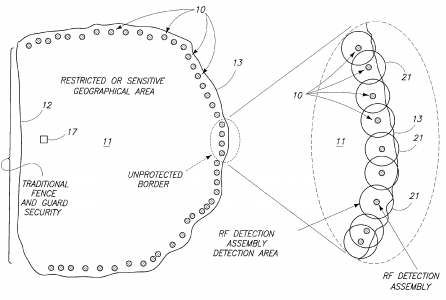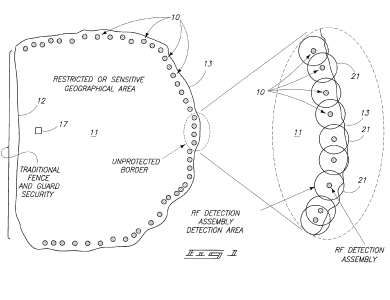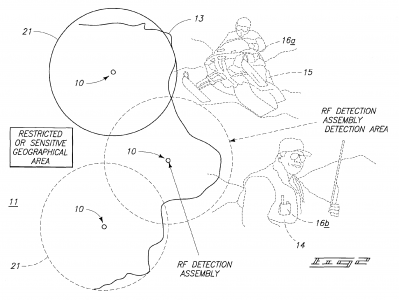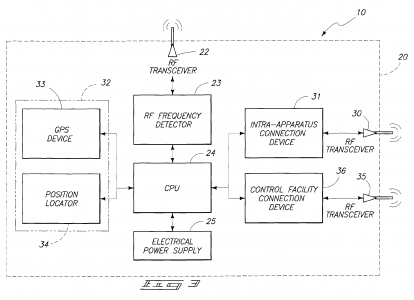Radio frequency detection assembly and method for detecting radio frequencies
What It Does (in plain English):
This invention describes a hardware module and system method for detecting and using radio frequency (RF) emanations (e.g., from a cell phone) to detect when individuals are crossing geographic borders. In large border areas (e.g., large test ranges or national boundaries), it is cost prohibitive to deploy sufficient personnel to monitor all of the border all of the time. Empirical data has shown that most people carry cell phones when traveling – even when surreptitiously crossing geographic boundaries. This invention describes the construction of small RF detection modules that monitor commonly used radio frequencies. These RF detection modules can then be used to detect a large number of surreptitious border crossers can by virtue of detecting their RF emanations.
|
Patent Info:
Abstract A radio frequency detection assembly is described and which includes a radio frequency detector which detects a radio frequency emission produced by a radio frequency emitter from a given location which is remote relative to the radio frequency detector; a location assembly electrically coupled with the radio frequency detector and which is operable to estimate the location of the radio frequency emitter from the radio frequency emission which has been received; and a radio frequency transmitter electrically coupled with the radio frequency detector and the location assembly, and which transmits a radio frequency signal which reports the presence of the radio frequency emitter. |
Images:
Claims: Description:
The United States Government has certain rights in this invention pursuant to Contract No. DE-AC07-05ID14517 between the United States Department of Energy and Battelle Energy Alliance, LLC. The present invention relates to a radio frequency detection assembly, and method for detecting radio frequencies, and more specifically to an assembly which can be easily deployed along a boundary of a restricted geographical region, and which can identify, locate, monitor and thereafter notify an intruder or trespasser of their presence within the restricted geographical region in order to effect their departure from same. Many commercial and government facilities which conduct sensitive operations are often located in such large geographical areas that fencing their perimeter, and providing guards for the same geographical area is financially impractical. Still further, many of these commercial and government facilities are located in remote regions and often border on recreational areas such as national parks, national forests, and other similar areas. Heretofore, many individuals have often entered into such restricted or security-sensitive geographical areas either intentionally or by accident while engaged in various recreational pursuits. Accidental trespassers who have come into these restricted geographical regions have included hunters, recreational ATV riders, snowmobilers, hikers, and curious tourists. The entrance of these types of individuals into secure, but otherwise sensitive geographical regions can be dangerous to the trespasser, as well as compromise confidential processes being conducted in the restricted or sensitive geographical region. For example, such sensitive areas may include bombing ranges, and ordinance disposal areas which are often located within such sensitive regions. Currently, more than 180,000,000 cellular telephones are now in use within the United States alone. Many individuals such as hunters, vacationers, and others carry cell phones when they are traveling in remote regions. Such cell phones, when placed in an on condition produce an RF signal even when the cell phone is not being used to make a call, that is, when it is sitting in an idle condition. A radio frequency detection assembly and method for detecting radio frequencies which can detect cellular telephone radio frequency signals or other RF signals from hand held VHF or UHF radios within a sensitive area for purposes of determining the presence of a trespasser or other unauthorized individual within a restricted or otherwise sensitive geographical region is the subject matter of the present application. A first aspect of the present invention relates to a radio frequency detection assembly which includes a radio frequency detector which detects a radio frequency emission produced by a radio frequency emitter from a given location which is remote relative to the radio frequency detector; a location assembly electrically coupled with the radio frequency detector and which is operable to estimate the location of the radio frequency emitter from the radio frequency emission which has been received; and a radio frequency transmitter electrically coupled with the radio frequency detector and the location assembly, and which transmits a radio frequency signal which reports the presence of the radio frequency emitter. Another aspect of the present invention relates to a radio frequency detection assembly which includes a first radio frequency transceiver which detects a radio frequency emission produced by a communications device from a given restricted geographical region which is remote relative thereto; a central processing unit electrically coupled with the first radio frequency transceiver, and which controls the operation of the radio frequency detection assembly; a second radio frequency transceiver which is electrically coupled with the central processing unit and which communicates with another radio frequency detection assembly which is deployed near the given restricted geographical region; a control facility which is positioned remotely relative to the radio frequency detection assembly and which can communicate with the communications device which is located within the given restricted geographical region; a location assembly electrically coupled with the central processing unit and which estimates the location of the communications device within the given restricted geographic region from the radio frequency emission produced by the communications device; and a third radio frequency transceiver which is electrically coupled with the central processing unit and which transmits a message to the control facility to notify the control facility of the presence of the communications device within the restricted geographical region, and wherein the control facility transmits a message to the communications device to warn a user of the communications device that the user is in a restricted geographical region. Another aspect of the present invention relates to a method for detecting radio frequencies which includes the steps of deploying a radio frequency detector in a given geographical region; detecting an emitted radio frequency produced by a communication device within the given geographical region by means of the radio frequency detector; and reporting the presence of the communication device within the geographical region to a control facility. Still another aspect of the present invention relates to a method for detecting radio frequencies which includes the steps of deploying a radio frequency detector within a given restricted geographical region; providing a control facility which has responsibility for securing the given restricted geographical region; detecting an emitted radio frequency produced by a cellular telephone or a two-way radio within the restricted geographical region; determining the geographic location of the cellular telephone or two way radio within the restricted geographical region based, at least in part, upon the emitted radio frequency of the cellular telephone or two-way radio; reporting the geographical location of the cellular telephone or two-way radio within the restricted geographical region to the control facility; and communicating with the cellular telephone or two-way radio in a fashion so as to advise a user of the cellular telephone or two-way radio of their location within the restricted geographical region. These and other aspects of the present invention will be described in greater detail hereinafter. Preferred embodiments of the invention are described below with reference to the following accompanying drawings. This disclosure of the invention is submitted in furtherance of the constitutional purposes of the U.S. Patent Laws “to promote the progress of science and useful arts” (Article 1, Section 8). Referring now to Referring first to In the arrangement as seen in Referring still to The global positioning system receiver 33 and position locator 34 are electrically coupled to and controlled by the central processing unit 24. Still referring to The operation of the described embodiment of the present invention is believed to be readily apparent and is briefly summarized at this point. In its broadest aspect the present invention relates to a radio frequency detection assembly 10 which includes a radio frequency detector 23 which detects a radio frequency emission produced by a radio frequency emitter such as a cellular telephone 16 a or two-way radio 16 b from a given location which is remote relative to the radio frequency detector 23. The radio frequency detection assembly 10 further includes a location assembly 32 which is electrically coupled with the radio frequency detector 23, and which is operable to estimate the location of the radio frequency emitter 16 a or 16 b from the radio frequency emission which has been received. Still further, the invention 10 includes a radio frequency transmitter 35 coupled with the radio frequency detector 23, and the location assembly 32, and which transmits a radio frequency signal which reports the presence of the radio frequency emitter such as a cellular telephone 16 a or two-way radio 16 b. In the arrangement as seen in The present invention, as earlier described, includes an electrical power supply 25 and which may be selected from the group comprising charge storage devices; wind generators; solar panels; or a continuous source of electricity. The present invention also includes a location assembly 32 which may comprise a global positioning device 33, or a position locator 34 which may be rendered operable to estimate the location of the radio frequency emitter such as the cellular telephone 16 a or two-way radio 16 b by triangulating the radio frequency emissions sent by the emitter relative to nearby radio frequency detection assemblies 10. As earlier described, the control facility 17 is operable to send a radio signal which may comprise an audible, text message, or both, to the radio frequency emitter such as the cellular telephone or two-way radio 16 a and 16 b to alert the user thereof that they are in a restricted or sensitive geographical region 11. The present invention includes a method for detecting radio frequencies which broadly includes the steps of deploying a radio frequency detector 23 in a given geographical region 11; detecting an emitted radio frequency produced by a communication device such as a cellular telephone 16 a or two-way radio 16 b within the given geographical region 11 by means of the radio frequency detector 23; and reporting the presence of the communication device 16 a or 16 b within the geographical region to a control facility 17. In the methodology as described, and after the step of detecting the emitted radio frequency produced by the communication device 16 a or 16 b, the method includes the step of estimating the location of communication device within the geographical region 11. Still further, the present method includes, after the step of reporting the presence of a communications device within the geographical region, communicating with the communications device 16 a or 16 b from the control facility 17 to advise a user of the communications device of their presence within the geographical region 11. This step of communicating with the communications device may include another step of transmitting an audio, text message, or both to the cellular telephone, or a two way radio to advise the user of the device to leave the geographical area. Still further, the present methodology may include after the step of reporting the presence of the communication device within the restricted region, and a further step of dispatching personnel to the restricted region to remove a user of the communications device 16 a or 16 b from the restricted region. Therefore, the methodology of the present invention for detecting radio frequencies includes the steps of deploying a radio frequency detector 23 within a given restricted geographical region 11; and providing a control facility 17 which has responsibility for securing the given restricted geographical region 11. The method includes a further step of detecting an emitted radio frequency produced by a cellular telephone 16 a or a two-way radio 16 b within the restricted geographical region 11; and determining the geographic location of the cellular telephone or two way radio within the restricted geographical region 11 based, at least in part, upon the emitted radio frequency of the cellular telephone or two-way radio. Still further, the methodology includes another step of reporting the geographical location of the cellular telephone 16 a or two-way radio 16 b within the restricted geographical region 11 to the control facility 17; and communicating with the cellular telephone or two-way radio in a fashion so as to advise a user of the cellular telephone or two-way radio of their location within the restricted geographical region. As earlier discussed, the step of deploying the radio frequency detection assembly 10 comprises deploying a plurality of radio frequency detection assemblies in spaced relation within the restricted geographical region 11. As noted earlier, and in the methodology of the present invention, the method includes another step of determining the geographical location of the radio frequency detector which is detecting the emitted radio frequency being produced by the cellular telephone or two-way radio. This may be achieved by utilizing the GPS device 33 which is provided with the present invention 10. Still further, the step of determining the geographical location of the cellular telephone 16 a or two-way radio 16 b further comprises triangulating the location of the emitted radio frequency produced by the cellular telephone from at least two radio frequency detectors 23 by utilizing the position locator 34. The method of the present invention also includes a step of providing a renewable energy source for energizing the radio frequency detection assembly 10; and further enclosing the radio frequency detection assembly and its components within a weatherproof enclosure 20. The present methodology may also include another step of providing a substantially continuous energy source for energizing the radio frequency detector 23. Therefore, it will be seen that the present invention provides a convenient means whereby the remote boundaries of a restricted region, and which may be intentionally or inadvertently crossed by an individual may be monitored, and a means is provided by which a control facility can communicate with a trespasser who is carrying a cellular telephone, or two-way radio 16 a and 16 b in a fashion where they can be advised that they have crossed into a restricted region and can be promptly instructed to leave the region. In compliance with the statute, the invention has been described in language more or less specific as to structural and methodical features. It is to be understood, however, that the invention is not limited to the specific features shown and described, since the means herein disclosed comprise preferred forms of putting the invention into effect. The invention is, therefore, claimed in any of its forms or modifications within the proper scope of the appended claims appropriately interpreted in accordance with the doctrine of equivalents.



